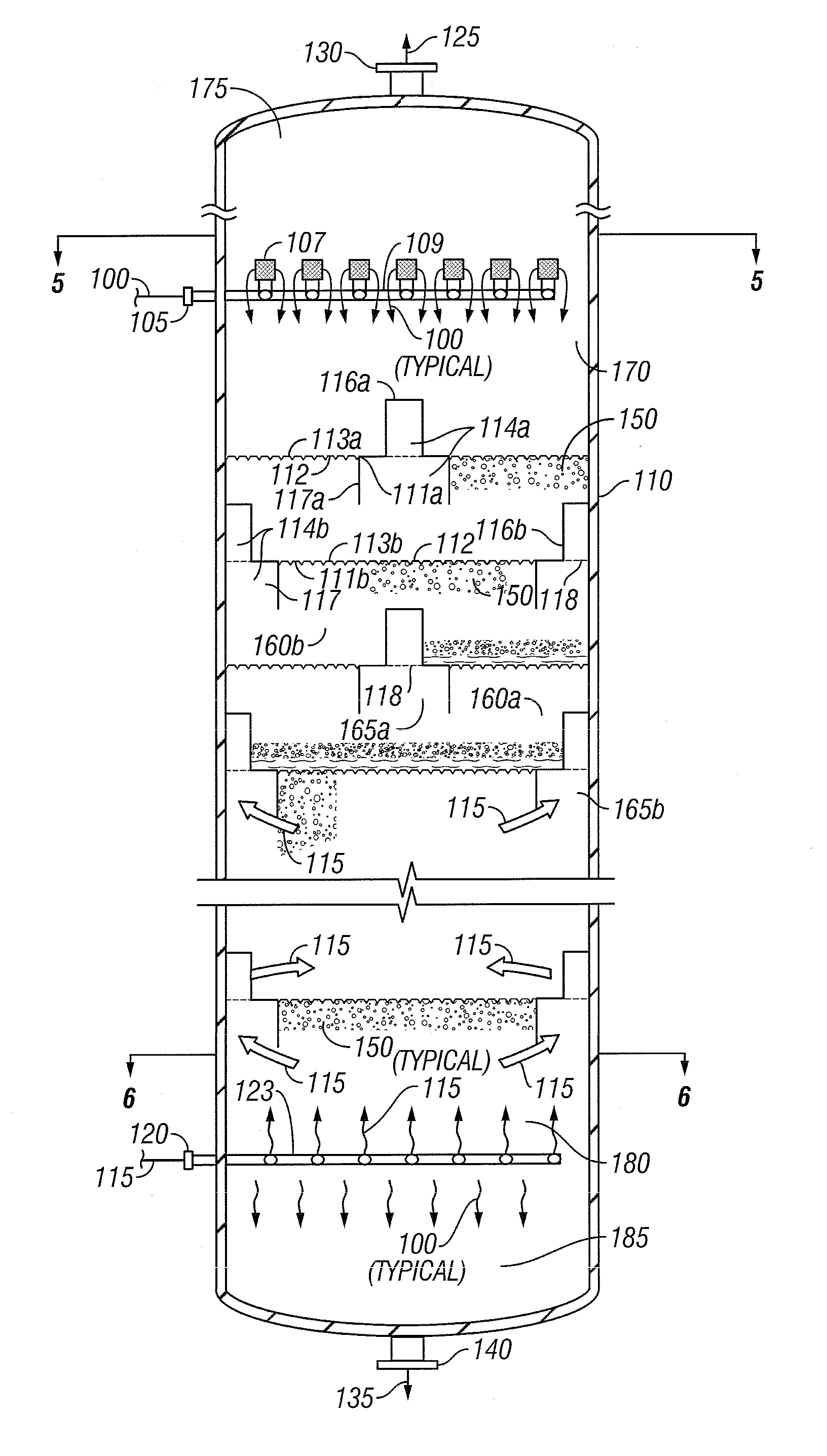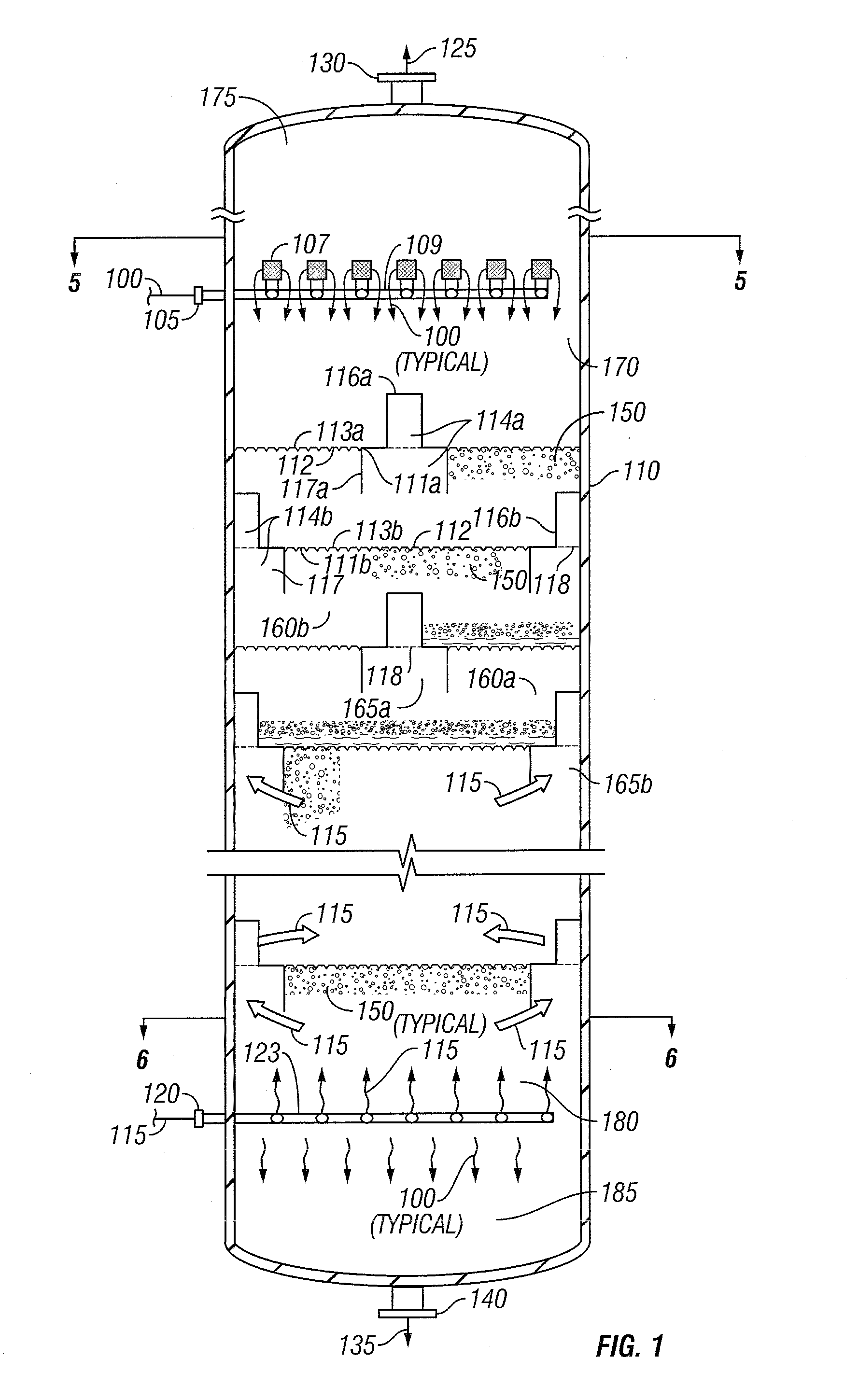Liquid-liquid extraction apparatus and method
a technology of liquid-liquid extraction apparatus and method, which is applied in the direction of selective extraction, liquid displacement, working up pitch/asphalt/bitumen, etc., can solve the problems of reducing extraction efficiency and capacity, premature flooding, and increasing the complexity of the tray riser, so as to facilitate the restoration of the degraded perforation area. , the effect of proportionally slowing the loss rate of the tray perforation area
- Summary
- Abstract
- Description
- Claims
- Application Information
AI Technical Summary
Benefits of technology
Problems solved by technology
Method used
Image
Examples
example 1
[0086] The present invention can be compared to alternative methods for liquid-liquid extraction in applications both as grassroots process designs and as retrofits to existing systems. For deasphalting of lubricating oil (lube oil) feedstocks, the prior art has used rotating disc contactors (RDC's) and packed-bed extraction vessels. Table 1 compares the present invention with RDC's using estimates of performance for selected operating parameters.
TABLE 1Performance Estimates for Solvent Deasphalting In PresentInvention Relative to Rotating Disc Contactor BaselineParameterPerformance of Present InventionLiquid Capacity20≧35% throughput increaseExtraction Efficiency2 times RDCProduct Yield0.5-5 volume percent increaseOperating CostLowerInvestment CostLower
[0087] RDC's consume energy to drive the disc contactors, which are not required in the present invention. Also, given an advantage in separation efficiency and capacity for the present invention, an RDC unit must consume extra pow...
example 2
[0089] To illustrate a range of retrofit options, Table 2 lists six cases of design dimensions for a lube oil solvent deasphalting application using the design of FIGS. 1-4, with reference to FIGS. 9-10 for simplified diagrams of sieve trays relating to dimensions in Table 2. The cases are for a potential retrofit of an existing RDC unit.
TABLE 2RDC RETROFIT CASESHeavy liquid flow = 93 m3 / hCommon Bases:Light liquid flow = 306 m3 / hParameterOption 1Option 2Option 3Option 4Option 5Option 6Vessel ID, m3.63.63.63.63.63.6Vessel Area, m210.1810.1810.1810.1810.1810.18Riser Area, m22.753.263.563.874.285.00Riser Area, % of273235384249VesselDeck Area, m27.436.926.626.315.905.18Perforation0.0420.0560.0840.1680.2480.112Area, m2Perforation689.5131925Diameter, mmPerforation1498112411831266874229Count Per Tray
[0090] A common basis in Table 2 is that each option at least meets the product specification of the RDC unit targeted for retrofit. In meeting the product specifications, the inventive optio...
example 3
[0091] An extraction vessel conceptually similar to that shown in FIG. 1 is used in a liquid-liquid extraction process to remove asphaltene compounds from a lubricating oil raffinate feed stream, using propane as a solvent. Table 3 provides ranges of values for the compositions of the feed, extract, and raffinate product streams.
[0092] A lube oil feed stream is introduced as the heavy-phase liquid 100, entering the upper inlet 105 at a temperature of 100-250° F. The feed contains 50-90 volume percent asphaltene constituents. Simultaneously, propane is introduced at the lower inlet 120 at a flow rate of 5 to 15 times the volumetric flow of the feed and a temperature of 100-200° F. The extraction is operated with a temperature differential of 0-40° F. with respect to the oil feed temperature. The vessel 110 is operated at 2.75-4.8 MPa (400-700 psig). The raffinate product 135 is withdrawn at the bottom outlet 140 of the vessel 110 and contains a major fraction of the asphaltenes. An ...
PUM
| Property | Measurement | Unit |
|---|---|---|
| Length | aaaaa | aaaaa |
| Volume | aaaaa | aaaaa |
| Volume | aaaaa | aaaaa |
Abstract
Description
Claims
Application Information
 Login to View More
Login to View More - R&D
- Intellectual Property
- Life Sciences
- Materials
- Tech Scout
- Unparalleled Data Quality
- Higher Quality Content
- 60% Fewer Hallucinations
Browse by: Latest US Patents, China's latest patents, Technical Efficacy Thesaurus, Application Domain, Technology Topic, Popular Technical Reports.
© 2025 PatSnap. All rights reserved.Legal|Privacy policy|Modern Slavery Act Transparency Statement|Sitemap|About US| Contact US: help@patsnap.com



